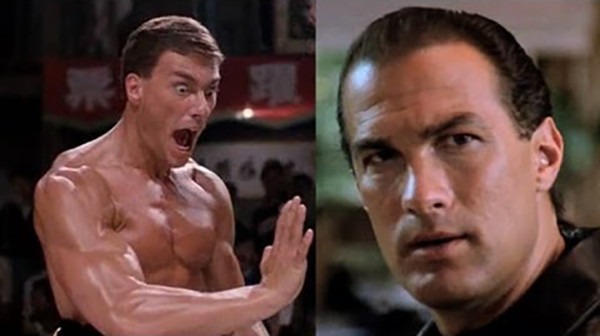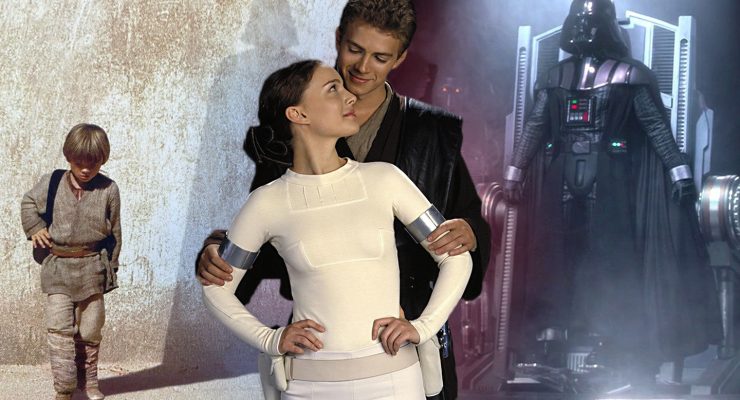As audiences get ready for another trip to Woodsboro, George Nash takes a look at the most playful moments from the influential slasher film franchise…
“Hello Sidney … it’s an honour,” crackles the now-iconic tones of Roger L. Jackson’s voice in the trailer for the forthcoming Scream film. Twenty-five years since Neve Campbell’s smart, resourceful final girl first etched her name into the annals of slasher folklore, it’s a sentiment fans of Wes Craven’s quippy, postmodern romp would certainly share.
That’s because, aside from the unwavering likeability of its heroine, the primary reason the Scream series has managed to retain its immense popularity, even as it expands into the very franchise territory it so playfully mocked in the 1990s, is its ability to continually tailor its slasher modus operandi to an entirely new generation.
And much of that can be attributed to the films’ shrewd propensity for knowing self-reference: a seemingly insatiable appetite for the kind of overtly tongue-in-cheek, wink-nudge meta-ness that can now be found in almost every dark, dank corner of the horror genre.
So, as audiences gear up for another date with Ghostface on January 14th, here are ten of the Scream franchise’s most memorably meta moments.
(Note: This list only includes moments from the Scream film series and not the spin-off TV show)
The Opening (Scream)
What Psycho likely did for bathroom locks in 1960, Scream did for caller ID in 1996. What Hitchcock took 30 minutes to do, Craven did in just 12. But bumping off the film’s biggest name before most of the audience had settled in their seats was just the start. For while it’s only briefly hinted at why Drew Barrymore’s unsuspecting Casey Becker and her boyfriend meet such grisly ends at the start of Scream, the scene remains a perfectly holistic encapsulation of all that the film has come to represent. The sudden jump from flirtatious chat to menacing threat; the blend of brutality and humour; the razor-sharp self-reference (“Never say ‘who’s there?’ Don’t you watch scary movies? It’s a death wish”): it all makes for a quarter of an hour that for a quarter of a century has become the gold standard for an entire sub-genre.
Craven’s cameo (Scream)
Like creepy rural roads and shoddy phone signal, like strange noises and irrational investigative impulses, director cameos and horror movies just seem to go together. For decades, auteurs of the macabre—from Hitchcock to M. Night Shyamalan—have been conspicuously cropping up in their projects with all the subtlety of a chainsaw-swirling maniac. Craven was no different, ensuring his cameos were almost always lathered in a generous dose of meta mischief. In 1994 he famously played himself in New Nightmare before appearing in Scream two years later as a Woodsboro high school janitor called Fred sporting a rather familiar fedora and red striped sweater combo…
Murder at the Movies (Scream 2)
The movie within a movie trope was nothing new by the time Scream 2 came bounding into town in 1997. But series creator Kevin Williamson gave it something of a novel spin: the movie within the movie was based on the events of the original film. It’s a nifty development that gives the sequel an added layer of pointed self-reference. So as Jada Pinkett Smith and Omar Epps meet their maker while a dramatised version of Scream’s iconic opening plays out in the background, Scream 2’s curtain raiser becomes at once a mirroring and neat inversion of its predecessor, dispatching household names not in a remote location but a packed movie theatre, filled with not one but hundreds of people dressed in Ghostface get-up. The pair’s early demise is also something of a deliberate double-bluff: the doomed couple vehemently rebuke the short lifespan of black characters in horror movies only for Craven to off them minutes later.
The Rules (Scream)
Described in the script as the gangly fifth wheel, it’s little surprise that Jamie Kennedy’s Randy Meeks would quickly become one of the franchise’s most important and beloved supporting characters. His genre-savvy cinephile is, after all, an adorable, eccentric proxy for the audience. And never is this more apparent than in what has arguably become Scream’s most enduring scene: the moment Randy imparts upon his fellow teens the golden rules for surviving a horror film and, in doing so, voicing what viewers had been shouting into the dark void of multiplexes for decades. No sex, no drink, no drugs and certainly no utterance of the line “I’ll be right back”: laws of slasher mor(t)ality that, of course, the characters of Scream soon finds ways to break unreservedly.
Director qualms (Scream 3)
Originally intended as the final chapter (a promise that in horror is as watertight as a cardboard box), Scream 3 often gets a rough ride. Its satire of movie trilogies is largely seen as something of a series outlier, a dip in form not least due to Williamson’s absence from the writer’s room. But two decades on, the film, and its recurring if rather underdeveloped ideas about Hollywood, transactional sex, and predatory men in positions of power, has undergone something of a surprise re-evaluation in the post-Weinstein era. It also remains arguably the most playful of all the sequels: a myriad of meta-ness that sees Scream’s principal characters running around Tinseltown alongside the fictional actors playing them in the series’ franchise within a franchise. There are knowing, irreverent jabs aplenty: none more so than the moment down-on-his-luck director, Roman Bridger (Scott Foley), complains that halting production on Stab 3 will likely scupper his true ambition of helming a classic love story—a pointed nod to Craven’s own motivations for returning for part three as a means of securing funding for Music of the Heart.
Behind You, Jamie (Scream)
Of its myriad movie references—from Friday the 13th to All the Right Moves; Sharon Stone to Tori Spelling—it is Halloween, John Carpenter’s seminal slasher from 1978, that Scream leans most heavily on. Yet, of all Craven’s homages to Carpenter’s classic—the uncanny white mask; the Loomis name (itself lifted from Hitchcock’s Psycho); the seemingly throwaway reference to the Mackenzies during the film’s opening—the most creative also comes during the most overt.
While watching the film alone at a party, an inebriated Randy (played by Jamie Kennedy) urges Jamie Lee Curtis’s Laurie Strode to look behind her at the very moment Scream’s own knife-wielding villain is creeping up on him. It’s Jamie warning Jamie: a pantomime of meta mayhem enhanced by a covertly placed portable camera that creates a multiple mirroring effect, one in which the audience find themselves watching someone watching someone else being pursued by a masked killer who in turn is watching someone being targeted by another masked murderer. It’s the slasher equivalent of the Droste effect.
https://youtu.be/SFyy-76MeOE
The sequel discussion (Scream 2)
If Scream was a playground of postmodern quips and shrewd deconstructions of genre, its follow up is a theme park. In one of the film’s standout moments, a class of cinema-savvy college students heatedly debate the merits of movie sequels while giving their takes on whether the new spate of murders is something of a real-life follow-up to the events of the first film. “The entire horror genre was destroyed by sequels,” laments one of them in a joyously on-the-nose scene that, complete with misquoted movie dialogue and shoddy Arnie impressions, is at once playful and self-deprecating: poking fun while acknowledging the supposedly innate inferiority of its own existence.
New beginnings (Scream 4)
Released more than a decade after the third instalment, Scream 4 had the unenviable task of reigniting a series that had itself reinvigorated an entire sub-genre in the 1990s. A movie celebrated for playfully poking fun at tired horror movie conventions and done-to-death sequels had now become a fully-fledged franchise. Such irony was certainly not lost on returning screenwriter Williamson, who tapped into the spirit of the first three films with a fittingly memorable opening that is, well, several openings in one: each a curtain raiser for the numerous sequels to Scream’s movie series within a movie series.
Fan anger (Scream 3)
Killing off a fan favourite in any series rarely goes down well, but in the case of the much-loved Randy’s rather sudden and unexpected departure in Scream 2, author John Muir, in his book Wes Craven: The Art of Horror, went so far as to call it the “most devastating moment of the sequel”. And he wasn’t the only one with strong feelings on the matter: Craven reportedly received a flood of hate mail to his official website shortly after the film was released.
Yet despite the backlash, Randy’s death remains an altogether necessary evil: if the viewer-incarnate can’t make it to the end credits, then is anyone truly safe? The animosity might have simmered somewhat by the time Scream 3 came around in 2000, but Craven and co. went someway to appeasing disgruntled fans by bringing the rule-spouting teen back in a short cameo via a posthumous video tape. But, in true Scream fashion, the film couldn’t simply let the ill-feeling pass without acknowledgement, so when Tyson (Dean Richmond), the character playing a Randy substitute named Ricky in Stab 3, suggests the killer could be “some psycho fan pissed off they killed Randy in Stab 2,” that’s the movie very much having the last laugh.
Carrie Fisher badmouths Carrie Fisher (Scream 3)
From the original film’s two-killer twist to Dewey’s apparent immortality to Courtney Cox’s fringe, the Scream franchise is packed full of surprises. None, however, are quite as unforeseen as Carrie Fisher’s cameo in Scream 3, popping up briefly as an actor-turned-film archivist by the name of Bianca Burnette. After rebuffing the inevitable resemblance to Fisher, she then remarks that she was indeed up for the part of Princess Leia. “So, who gets it?” she says bitterly, “the one who sleeps with George Lucas.” Entirely unexpected. Entirely memorable.
George Nash is a freelance film journalist. Follow him on Twitter via @_GeorgeNash for more movie musings.











